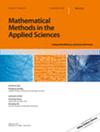Semigroup Dynamics and Chaotic Behavior in Second-Order Partial Differential Equations on H1×L2 Space
IF 2.1
3区 数学
Q1 MATHEMATICS, APPLIED
引用次数: 0
Abstract
This paper focuses on the dynamics of a second-order partial differential equation within the space described by Under suitable conditions on the parameters , and , we demonstrate that the solution of the linearized version of our proposed model generates mixing, chaotic, and distributionally chaotic strongly continuous semigroups on the product space . Additionally, our treatment of the nonhomogeneous model establishes that its solution, while not generating a strongly continuous semigroup, exhibits chaotic and distributionally chaotic behavior on the space . Moreover, we provide a compelling application of our proposed model, showcasing instances where chaos manifests.
本文主要研究空间 L 2 $$ {L}^2 $$ 内的二阶偏微分方程的动力学特性,描述为 ∂ 2 ϑ ( x , t ) ∂ t 2 + a ϑ ( x , t ) ∂ t + b ϑ ( x , t ) = c ∂ 2 ϑ ( x , t ) ∂ x 2 + h ( x , t ) , a , b , c > 0 . $$ \frac\{partial^2\vartheta \left(x,t\right)}{partial {t}^2}+a\frac\{partial \vartheta \left(x,t\right)}{partial t}+;b 和amp;#x0003d;c(左)和amp;#x0005E;2(右)}{和amp;#x0005E;2}+h(左),a,b,c>0。$$ 在参数 a , b $$ a,b $$ 和 c $$ c $$ 的合适条件下,我们证明了我们提出的模型的线性化版本的解会在乘积空间 H 1 × L 2 $$ {H}^1\times {L}^2 $$ 上产生混合、混沌和分布混沌强连续半群。此外,我们对非均质模型的处理证明,其解虽然不会产生强连续半群,但在空间 H 1 × L 2 $$ {H}^1\times {L}^2 $$ 上表现出混沌和分布混沌行为。此外,我们还提供了我们提出的模型的令人信服的应用,展示了混沌表现的实例。
本文章由计算机程序翻译,如有差异,请以英文原文为准。
求助全文
约1分钟内获得全文
求助全文
来源期刊
CiteScore
4.90
自引率
6.90%
发文量
798
审稿时长
6 months
期刊介绍:
Mathematical Methods in the Applied Sciences publishes papers dealing with new mathematical methods for the consideration of linear and non-linear, direct and inverse problems for physical relevant processes over time- and space- varying media under certain initial, boundary, transition conditions etc. Papers dealing with biomathematical content, population dynamics and network problems are most welcome.
Mathematical Methods in the Applied Sciences is an interdisciplinary journal: therefore, all manuscripts must be written to be accessible to a broad scientific but mathematically advanced audience. All papers must contain carefully written introduction and conclusion sections, which should include a clear exposition of the underlying scientific problem, a summary of the mathematical results and the tools used in deriving the results. Furthermore, the scientific importance of the manuscript and its conclusions should be made clear. Papers dealing with numerical processes or which contain only the application of well established methods will not be accepted.
Because of the broad scope of the journal, authors should minimize the use of technical jargon from their subfield in order to increase the accessibility of their paper and appeal to a wider readership. If technical terms are necessary, authors should define them clearly so that the main ideas are understandable also to readers not working in the same subfield.

 求助内容:
求助内容: 应助结果提醒方式:
应助结果提醒方式:


